hi all! i would like to have some info on seaxes because i'm doing a seax project and i need to know if it takes a distal taper.
second i would like to know how thick a 22" (17 1/4" blade) seax and could be to be functional. and how would be the width of this monster thats the question. Jean did a very nice drawing if he could put it in this post i would be grateful. :lol:
Saxes are popular these days :) What type of sax do you have in mind (narrow sax, light broadsax, heavy broadsax, longsax, broken back style sax, Frankish/Anglo-saxon/Scandinavian?). N.b. a hilt of only 4 3/4" is very short if you're going for an authentic reproductions. In terms of thickness, the heavy broadsaxes had thicknesses of around 10mm, with a width of around 5cm (or possibly wider even) and a similar blade length as you mention. Unfortunately I don't know very much about distal taper on saxes, as most drawings don't include that information. Some examples I've seen have slight to no distal taper though.
the seax's style is like the river thame but with a quite heavy look (big!!!) and to be more precise here is a link : http://www.myArmoury.com/talk/viewtopic.php?t...light=seax
but the difference is that there is no pommel no cross-guard and the blade is heavier, more wide like 3 inches wide at the bigger point. but i don't know if it's too heavy for a seax.
but the difference is that there is no pommel no cross-guard and the blade is heavier, more wide like 3 inches wide at the bigger point. but i don't know if it's too heavy for a seax.
| Etienne Hamel wrote: |
| hi all! i would like to have some info on seaxes because i'm doing a seax project and i need to know if it takes a distal taper.
second i would like to know how thick a 22" (17 1/4" blade) seax and could be to be functional. and how would be the width of this monster thats the question. Jean did a very nice drawing if he could put it in this post i would be grateful. :lol: |
Concept drawing of seax:
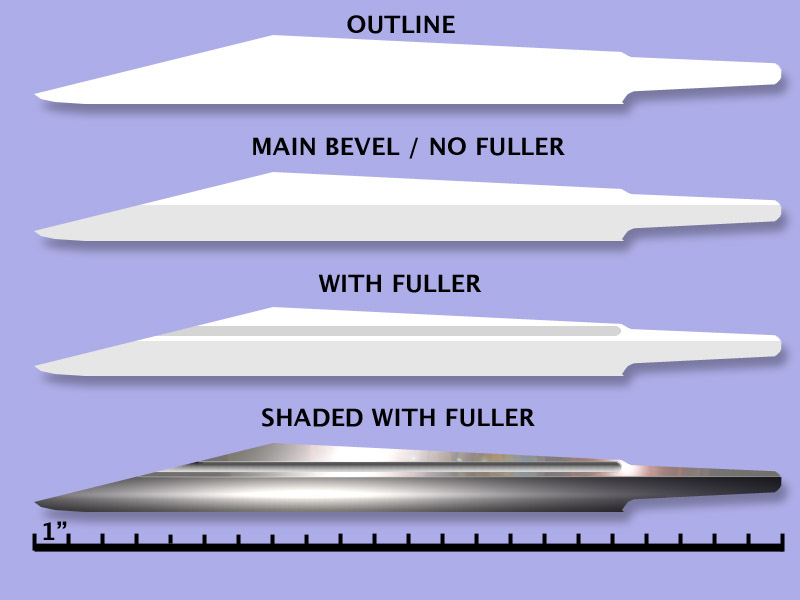
Jean, you should become a concept artist. ;)
| Hugo Voisine wrote: |
| Jean, you should become a concept artist. ;) |
Sometimes I am for my " custom " projects. ;)
Did this one for Étienne but if I decide to have a seax made for myself this could be it !
:lol:
Although I might make it into a langseax and add a couple of inches to a 20" blade but for a knife sized seax a 17" or 18" blade is long enough.
One thing I've mentioned before on another Topic thread about the seax is how much this type of broken back seax looks like a Bowie Knife. :eek:
The main difference being that I don't think the seax had a sharpened clip like most Bowie knives have or at least an uncharpened false edge bevel.
Oh, any style, historic or making advice for Étienne would be appreciated keeping in mind that he has very little cash to play with and only limited access to tools but he is starting out well by doing some serious research and might become one of our industry makers a few years from now. :D
Some thoughts:
Jean, your rendering has the look of a seax that is 1/2 or 2/3 of the size that is intended. Such dramatic proportions would make a blade of this size strange in handling, I think. You do see broken back seaxes with rather this profile, but my impression is that they are generally smaller.
A broken back seax of this lenght would have less widening towards the "hump": only slightly a very slight widening or even paralell sides and a rather narrow profile.
If you go with paralell sides, and a narrow profile with thicker back (8-10 mm) would be approproate.
A wider profile with moderate widening towards the "hump" might work with a slimmer back thickness (6-7mm?). I am not aware of any historical examples of Anglo-Saxon seaxes of this length with wider and thinner blades. But I may well just have overlooked them.
The cross section will have an influence on the thickness of the back (or the other way around): A more flat and triangular cross section can (and perhaps should) have a thicker back.
The fuller, or groove would typically follow the line of the back (as it is associated by the line of the back, rather than the blade centre or the edge).
Fullering can be a single groove, twin or tripple.
There is not much distal taper, but normally there will be some: a taper from base to crown of clip point, or "hump": perhaps 1,5-2 mm. There is also a natural tapering effect created by the clip point, as the slanting line of the back cuts through the cross section (the trick is often to keep the point from getting too thin!).
The tang length of the broken back seaxes of "Honey Lane" type (the ones that widen more dramatically towards the start of the clip point) are shorter than those found on the "Hurbuck" type, (the type with a more narrow outline and more or less paralell back and edge: also note that the "Hurbuck" type of broken back seaxes might have a concave edge: a downwards curve in the point part where the clip point start).
These are just recommendations in a general way. Each original seax you see would be a variation to this theme. As this blade is perhaps more of a dream come true project, rather than a strict interpretation of the historical material, you might use historical example as much as you think makes sense.
I do think that there is correlation between size, cross section and profile on these weapons. As these blades rely on mass distribution as a result of outline and cross section for their heft and balance, it might be a good idea to glance at the historical conterparts: they worked after all.
I attach a completely different seax, that I worked with a few years back. It belongs to the early narrow type, but has an unusual cross section and profile. It is fairly long, but still has a grip that only makes room for your hand and little more. We know the grip was short since the end of the tang was folded over the end of the grip. This blade is 10+ mm at the thickest part, right at the start of the "clip point". Notice also the concave curve of the edge: a drop of the point at the start of the clip point. This inverse curve is a natural result of heat treat.
A hefty blade that belies its visual impression: it loks like a narrow skewer, but does deliver a pretty formidable blow while also being a respectable mail link splitter or leather awl.
 Attachment: 37.31 KB
Attachment: 37.31 KB
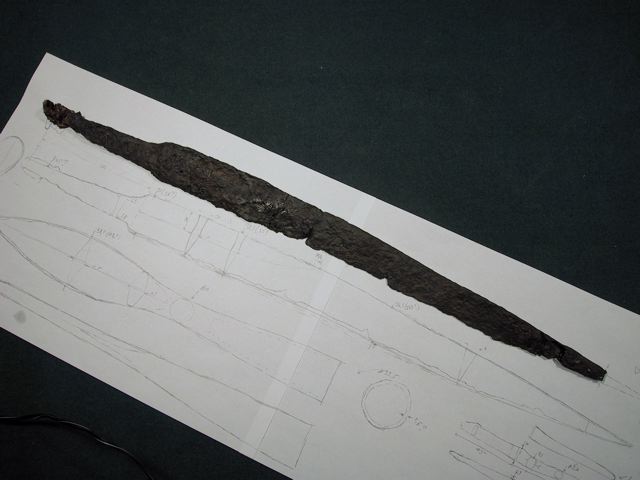
Original blade with the tracing
 Attachment: 20.9 KB
Attachment: 20.9 KB

Reconstruction
Jean, your rendering has the look of a seax that is 1/2 or 2/3 of the size that is intended. Such dramatic proportions would make a blade of this size strange in handling, I think. You do see broken back seaxes with rather this profile, but my impression is that they are generally smaller.
A broken back seax of this lenght would have less widening towards the "hump": only slightly a very slight widening or even paralell sides and a rather narrow profile.
If you go with paralell sides, and a narrow profile with thicker back (8-10 mm) would be approproate.
A wider profile with moderate widening towards the "hump" might work with a slimmer back thickness (6-7mm?). I am not aware of any historical examples of Anglo-Saxon seaxes of this length with wider and thinner blades. But I may well just have overlooked them.
The cross section will have an influence on the thickness of the back (or the other way around): A more flat and triangular cross section can (and perhaps should) have a thicker back.
The fuller, or groove would typically follow the line of the back (as it is associated by the line of the back, rather than the blade centre or the edge).
Fullering can be a single groove, twin or tripple.
There is not much distal taper, but normally there will be some: a taper from base to crown of clip point, or "hump": perhaps 1,5-2 mm. There is also a natural tapering effect created by the clip point, as the slanting line of the back cuts through the cross section (the trick is often to keep the point from getting too thin!).
The tang length of the broken back seaxes of "Honey Lane" type (the ones that widen more dramatically towards the start of the clip point) are shorter than those found on the "Hurbuck" type, (the type with a more narrow outline and more or less paralell back and edge: also note that the "Hurbuck" type of broken back seaxes might have a concave edge: a downwards curve in the point part where the clip point start).
These are just recommendations in a general way. Each original seax you see would be a variation to this theme. As this blade is perhaps more of a dream come true project, rather than a strict interpretation of the historical material, you might use historical example as much as you think makes sense.
I do think that there is correlation between size, cross section and profile on these weapons. As these blades rely on mass distribution as a result of outline and cross section for their heft and balance, it might be a good idea to glance at the historical conterparts: they worked after all.
I attach a completely different seax, that I worked with a few years back. It belongs to the early narrow type, but has an unusual cross section and profile. It is fairly long, but still has a grip that only makes room for your hand and little more. We know the grip was short since the end of the tang was folded over the end of the grip. This blade is 10+ mm at the thickest part, right at the start of the "clip point". Notice also the concave curve of the edge: a drop of the point at the start of the clip point. This inverse curve is a natural result of heat treat.
A hefty blade that belies its visual impression: it loks like a narrow skewer, but does deliver a pretty formidable blow while also being a respectable mail link splitter or leather awl.

Original blade with the tracing

Reconstruction
Last edited by Peter Johnsson on Tue 04 Sep, 2007 4:07 am; edited 1 time in total
| Peter Johnsson wrote: |
|
I attach a completely different seax, that I worked with a few years back. It belongs to the early narrow type, but has an unusual cross section and profile. It is fairly long, but still has a grip that only makes room for your hand and little more. We know the grip was short since the end of the tang was folded over the end of the grip. This blade is 10+ mm at the thickest part, right at the start of the "clip point". Notice also the concave curve of the edge: a drop of the point at the start of the clip point. This inverse curve is a natural result of heat treat. A hefty blade that belies its visual impression: it loks like a narrow skewer, but does deliver a pretty formidable blow while also being a respectable mail link splitter or leather awl. |
Some additions to Peter's comments: From the examples of broken back saxes I've seen, the width is fairly constant independed of length. Longer saxes are just stretched out lengthwise. I also notice a beveled edge in the drawings. The original broken back saxes had a triangular cross-section, with no additional bevels. The fullers, which aren't very common, generally run parallel to the spine of the blade.
Below are some examples (from my zipfile: http://1501bc.com/files/information_about_saxes.zip)
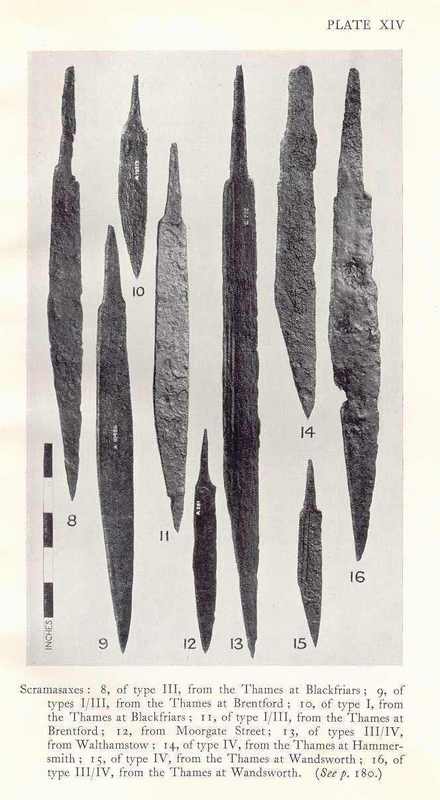
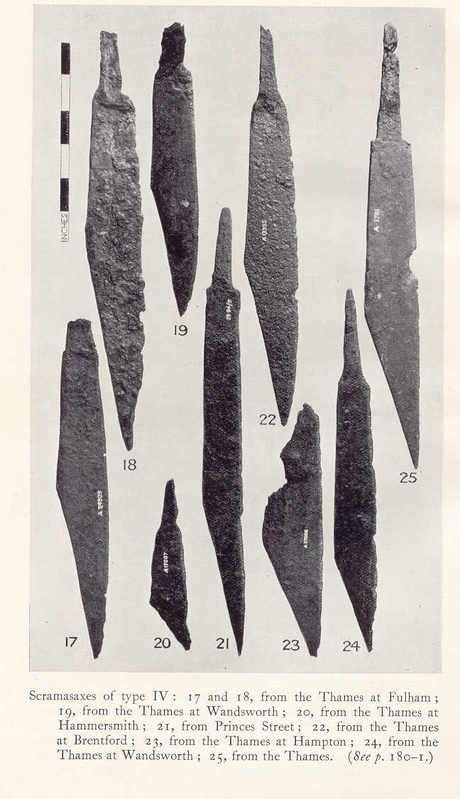
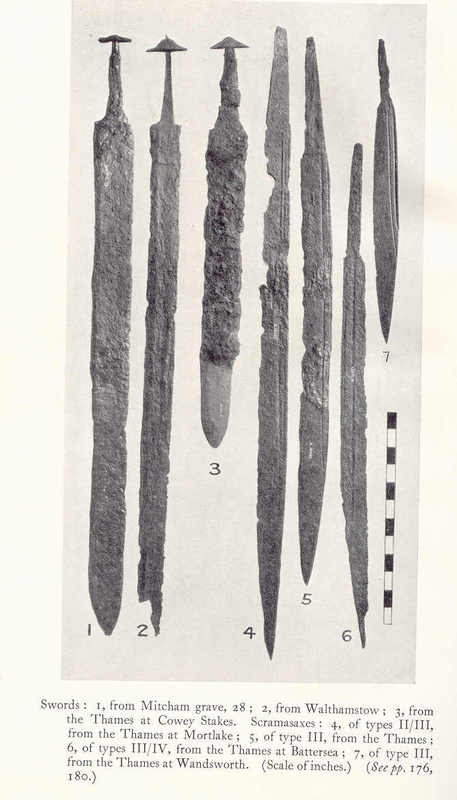
wow thats a really nice concept art jean! anyway i had no idea seaxes were that big. thats pretty cool learnin somethin new everyday lol im
| Jeroen Zuiderwijk wrote: |
| ...
Thanks Peter! That's quite an unusual sax. Where was it found? Some additions to Peter's comments: From the examples of broken back saxes I've seen, the width is fairly constant independed of length. Longer saxes are just stretched out lengthwise. I also notice a beveled edge in the drawings. The original broken back saxes had a triangular cross-section, with no additional bevels. The fullers, which aren't very common, generally run parallel to the spine of the blade. |
Hi Jeroen,
The seax was found in a warriors grave in Tomteboda, Stockholm. A new central hub complex for the national Post was to be built and the site chose had an old burial ground. One of the graves was that of a warrior: a lance, a seax, a fire steel (of awl type) a buckle and a brooch was found.
The dating is uncertain. The lance was of a type that seems to hint at early Vendel period. The seax is also of unusual shape and is therefore difficult to use for dating the grave.
I got to make reconstructions of all the metal objects in the grave. These are now on display in the entrance of the building. The grave is reconstructed below glass in the floor and the objects on display in cases. An interesting project.
The grip is a guess, of course. We kno only that the wood was probably maple and probably burly maple. It had some kind of element added with two rivets at the end. The rivets were preserved as small hubs of rust. The guess is that a reinforing bad was riveted in place. This is a feature that can be seen on other seaxes. It migh have had some kind of mounting at the blade ond of the grip, but no remains of that was left. The grip could also have been covered with leather, as some of the seaxes from the Vende/Valsgärde find show. There was nothing to support this, so the grip was left bare. It might be *less* authentic because of this, but we wanted to keep guesswork to a minimum. Obviously there was no carved decoration made in the grip. This might have been more or less universal for these weapons, as those that have grips in good enough preservation very often show traces of different kinds of decoration.
As to cross section of seaxe, yes, it is mostly triangular. *But* you will find examples where the trangle is pretty "fat", almost so much so that the cross section looks like a "house" with bulging sides. The "edge bevel" is not marked, but well rounded, so it blends into the cross section. You could describe the cros section like a gothic arch. I have the impression that this is a more common feature on those seaxes that are long and narrow in profile. It makes sense as you might want this extra mass for the narrower blade.
-Or go with an extra thick back.
| Jeroen Zuiderwijk wrote: |
| Saxes are popular these days :) What type of sax do you have in mind (narrow sax, light broadsax, heavy broadsax, longsax, broken back style sax, Frankish/Anglo-saxon/Scandinavian?). N.b. a hilt of only 4 3/4" is very short if you're going for an authentic reproductions. In terms of thickness, the heavy broadsaxes had thicknesses of around 10mm, with a width of around 5cm (or possibly wider even) and a similar blade length as you mention. Unfortunately I don't know very much about distal taper on saxes, as most drawings don't include that information. Some examples I've seen have slight to no distal taper though. |
Langbardian (langbarten, lombard) sax apparently had not, I took some careful visual appraisal os several specimens from a close distance in a museum and there was none.
I couldn't measure them, but the spine was in the 8 - 10 mms range of thicknes, the blade geometry being clearly triangular.
The archeological report I have on the saxes of montichiari (BS) shows that they were sheathed in leather with a probable wooden core, just like other germanic seaxes.
The fittings appear very close to the viking fittings we know so well.
point is diferent, however, showing a certain similarity to modern bowies.
| Peter Johnsson wrote: |
|
Hi Jeroen, The seax was found in a warriors grave in Tomteboda, Stockholm. A new central hub complex for the national Post was to be built and the site chose had an old burial ground. One of the graves was that of a warrior: a lance, a seax, a fire steel (of awl type) a buckle and a brooch was found. The dating is uncertain. The lance was of a type that seems to hint at early Vendel period. The seax is also of unusual shape and is therefore difficult to use for dating the grave. |
Thanks!
| Quote: |
| I got to make reconstructions of all the metal objects in the grave. These are now on display in the entrance of the building. The grave is reconstructed below glass in the floor and the objects on display in cases. An interesting project.
The grip is a guess, of course. We kno only that the wood was probably maple and probably burly maple. It had some kind of element added with two rivets at the end. The rivets were preserved as small hubs of rust. The guess is that a reinforing bad was riveted in place. This is a feature that can be seen on other seaxes. It migh have had some kind of mounting at the blade ond of the grip, but no remains of that was left. The grip could also have been covered with leather, as some of the seaxes from the Vende/Valsgärde find show. There was nothing to support this, so the grip was left bare. It might be *less* authentic because of this, but we wanted to keep guesswork to a minimum. Obviously there was no carved decoration made in the grip. This might have been more or less universal for these weapons, as those that have grips in good enough preservation very often show traces of different kinds of decoration. |
Am I correct in my observations that Swedish saxes have a very independend development from the rest of Europe? In most of Europe, you can recognize the same narrow sax/broadsax/longsax types, generally with similar blade shapes, hilts constructions/materials etc. From the examples I've seen from Sweden, they generally are very different.
| Quote: |
| As to cross section of seaxe, yes, it is mostly triangular. *But* you will find examples where the trangle is pretty "fat", almost so much so that the cross section looks like a "house" with bulging sides. The "edge bevel" is not marked, but well rounded, so it blends into the cross section. You could describe the cros section like a gothic arch. |
I've seen this on several broad saxes, but not on other types so far (at least not as pronounced).
| Quote: |
| I have the impression that this is a more common feature on those seaxes that are long and narrow in profile. It makes sense as you might want this extra mass for the narrower blade. |
It sacrifices the sharpness of the edge though, so it won't make a good cutter. So I assume that the narrow examples you refere to might have been mainly thrusting weapons? Although I did experience myself that the extra mass of a thicker blade can actually compensate to some extend for the wider cutting angle and can cut just as deep or even deeper as a thinner blade that's sharper but lighter. Makes it behave more like an axe though :)
| Peter Johnsson wrote: |
| As to cross section of seaxe, yes, it is mostly triangular. *But* you will find examples where the trangle is pretty "fat", almost so much so that the cross section looks like a "house" with bulging sides. The "edge bevel" is not marked, but well rounded, so it blends into the cross section. You could describe the cros section like a gothic arch. I have the impression that this is a more common feature on those seaxes that are long and narrow in profile. It makes sense as you might want this extra mass for the narrower blade.
-Or go with an extra thick back. |
A Gothic arch cross section would be somewhat like and elliptical cross section on a double edged blade but cut in half right down the middle.
Such a rounded cross section would also be easier to grind for an un-experienced maker that a sharp crisp and strait bevel I believe ?
Oh, thank Peter for all the information as my " rendering " is more what I would like aesthetically than a carefully researched historical seax. Since this is Étienne's project he is the one who has to decide how close to historical he wants to be.
The blade in the drawing may look very wide but it is supposed to be only 2" wide at it's widest and 1 1/2" just before the tang. The fuller being parrallel to the back rather than the the bevel line is a subtlety I wasn't aware about and I could redraw it that way if Étienne need a drawing to visuallyse it. ( I usually can just picture things in my mind without needing a drawing if it's just for me ).
I could reduce the width of the wide part making the blade almost but not quite parralel and have the clip start much earlier on the blade as with the example who have been kind enough to post.
Maybe I' ll wait until I get Étienne's opinion before I draw another modified version with no bevel or a rounded one that blends into the main side of the blade or gothic arch. ( anyway wait a few days or draw it just for the fun of it " sooner " ).
Oh, I also appreciate the respectful way you corrected what are historical " inaccuracies " by not assuming that my design intent was completely historical. :D :cool: Must admit to being " heavily " influenced by " modern " Bowie knives " and what I like and have designed in the past as custom knives i.e. huge scary Bowies 3/8" thick stock. :eek: :lol:
langbarten sax at discovery place
http://www.archeologiamontichiari.it/pop_up.asp?id=387
a complete set. Notice the fittings ...
http://www.archeologiamontichiari.it/pop_up.asp?id=336
http://www.archeologiamontichiari.it/pop_up.asp?id=387
a complete set. Notice the fittings ...
http://www.archeologiamontichiari.it/pop_up.asp?id=336
The first of my seaxes near completion.
Blade 52 cms by 3.6, no distal taper, thickness 5.5 mms
 Attachment: 118.68 KB
Attachment: 118.68 KB
[ Download ]
Blade 52 cms by 3.6, no distal taper, thickness 5.5 mms
[ Download ]
my brokeback new one after forging and forst rough grinding.
44 cms blade, tapers straight from 7 mms to 5 at the beginning of the almost straight slope. With final grinding it will likely lose almost a mm of surface.
Tangs in bot seaxes are longer than needed pending a decision on the hilt style (I'm perusing Jerome's seaxes pics and i wonder if i could do some nice bronze fittings).
Any suggestion about bronze fittings is warmly welcome.
 Attachment: 113.02 KB
Attachment: 113.02 KB
[ Download ]
 Attachment: 124.48 KB
Attachment: 124.48 KB
[ Download ]
44 cms blade, tapers straight from 7 mms to 5 at the beginning of the almost straight slope. With final grinding it will likely lose almost a mm of surface.
Tangs in bot seaxes are longer than needed pending a decision on the hilt style (I'm perusing Jerome's seaxes pics and i wonder if i could do some nice bronze fittings).
Any suggestion about bronze fittings is warmly welcome.
[ Download ]
[ Download ]
| Jeroen Zuiderwijk wrote: | ||
|
... Am I correct in my observations that Swedish saxes have a very independend development from the rest of Europe? In most of Europe, you can recognize the same narrow sax/broadsax/longsax types, generally with similar blade shapes, hilts constructions/materials etc. From the examples I've seen from Sweden, they generally are very different.
It sacrifices the sharpness of the edge though, so it won't make a good cutter. So I assume that the narrow examples you refere to might have been mainly thrusting weapons? Although I did experience myself that the extra mass of a thicker blade can actually compensate to some extend for the wider cutting angle and can cut just as deep or even deeper as a thinner blade that's sharper but lighter. Makes it behave more like an axe though :) |
Jeroen,
Perhaps you are correct in this. The continental seax with its typical outline: more or less symmetrical outline, curving to a more or less centrally placed point, is represented in the swedish material, but there are also other forms. You can find broad and long seaxes that are almost a mix between the continental and Anglo-Saxon types: a rounded type of clip point, with some elements from the continental seaxes.
How much this possibly local variation carries though to scabbards and grips, I cannot say.
I know that surviving examples of frankish seax scabbards look different than the surviving speciments I´ve seen from Vendel/Valsgärde.
In the Swedish finds of seaxes, you see grip lengths vary from just slightly longer than the width of the palm to 20-25 cm (these are lengths you can know as the ends of the tangs have been folded over the grip end). You alse see examples of metal rivet "washers", reinforcing bands and decorative domed nail head decoration (like the stocks of Indian rifles of the Wild West).
I am not certain how much this is a local scandinavian feature. So little is remaining of the material, that it might have been in use over a wider cultural area.
I think is wise to treat the material with some caution (and you certainly do that Jeroen!). The bare wooden grip is one such thing, however: we cannot know if the remaining wood was *all* there was. Perhaps it was, but I think it is very possible that wooden grips could have been cut with decorations, covered with leather and reinforced with thin metal bands. Nothing of this might remain and so our understanding of the actual design might well be as fragmentary as the state of the surviving originals.
On cutting and cross sections:
Yes the thickness would have an effect, but perhaps not so much as one migh think at first.
If the knife is heavy, then it will cleave deep despite having a thicker cross section. It might not win a rope cutting competition, but it will be an effective weapon all the same.
These knives are not skinning knives or wood working tools, after all ;-)
The one from Tomteboda I made a reconstruction of, could sink to the spine and beyond into a solid wooden stump with hardly any effort at all. Just a flick of the wrist, and it sunk into the wood with a low "Thunk!".
Ohhh... Peter you say such wonderful words... "Thunk"!
Tonight I will post my latest pictures of my loooong seax ... it has a long blade thick spine and isn´t that wide, about 4 cm on it´s widest point. Still some grinding to do on it.
Tonight I will post my latest pictures of my loooong seax ... it has a long blade thick spine and isn´t that wide, about 4 cm on it´s widest point. Still some grinding to do on it.
Bruno can you tell me more about your second seax? i think it's awsome!
| Jean Thibodeau wrote: | ||
I could reduce the width of the wide part making the blade almost but not quite parralel and have the clip start much earlier on the blade as with the example who have been kind enough to post. Maybe I' ll wait until I get Étienne's opinion before I draw another modified version with no bevel or a rounded one that blends into the main side of the blade or gothic arch. ( anyway wait a few days or draw it just for the fun of it " sooner " ). : |
Just did a new drawing using the imput from Peter Johnsson:
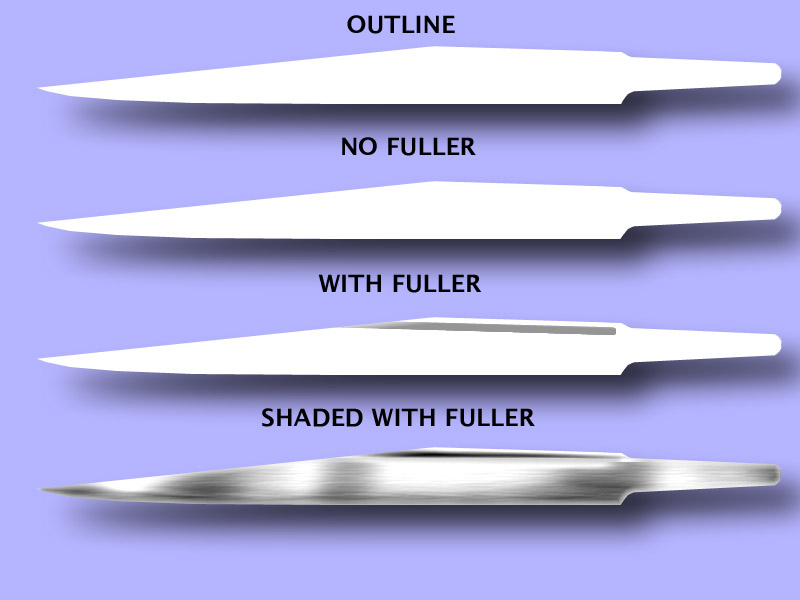
Page 1 of 2
You cannot post new topics in this forumYou cannot reply to topics in this forum
You cannot edit your posts in this forum
You cannot delete your posts in this forum
You cannot vote in polls in this forum
You cannot attach files in this forum
You can download files in this forum
All contents © Copyright 2003-2006 myArmoury.com — All rights reserved
Discussion forums powered by phpBB © The phpBB Group
Switch to the Full-featured Version of the forum
Discussion forums powered by phpBB © The phpBB Group
Switch to the Full-featured Version of the forum